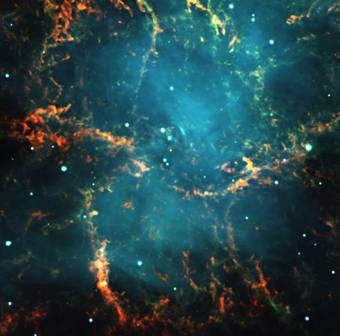Überraschende Erkenntnisse über die Entstehung der Elemente
2015-01-27 – Nachrichten aus dem Physik-Department

Die Lebenszeit von massereichen Sternen endet mit einer Supernova. Dabei explodiert der Stern und leuchtet kurzzeitig so hell wie eine ganze Galaxie. Bei solchen Explosion werden die schwereren chemischen Elemente wie Silber, Zinn oder Iod erzeugt und in den Raum zwischen den Sternen geschleudert. Auf ihrem Weg durch die Milchstraße fängt die Erde Staubpartikel dieser Explosionen ein, deren Elemente sich schließlich auf den Meeresböden ablagern und dort archiviert werden. Schon vor einigen Jahren hatten Physiker der TU München das langlebige Eisen-Isotop 60Fe in Tiefsee-Mangankrusten nachgewiesen, von dem man sicher ist, dass es in in Supernovae gebildet wird. Nun hat ein internationales Team von Forschern der Universität Wien, der TUM, der Australian National University, Canberra, und der Hebrew University, Israel, Proben vom Meeresboden auf interstellares Plutonium hin analysiert und dabei wichtige Erkenntnisse für das Verständnis der Entstehung schwerer Elemente entdeckt.
Plutonium-244 nachgewiesen
Die Forscher untersuchten Tiefseesedimente aus dem Pazifik, darunter eine 10 Zentimeter dicke Eisen-Mangan-Kruste aus 5000 Meter Tiefe. Diese über 25 Millionen Jahre alten Ablagerungen enthielten neben Spurenelementen aus dem Ozean auch Elemente des interstellaren Staubs, wie eine Analyse an der Beschleunigeranlange Vera in Wien zeigte. Die Physiker suchten nach einem Isotop von Plutonium, Plutonium-244, das auf der Erde natürlicherweise nicht vorkommt und mit einer Halbwertszeit von 81 Millionen Jahren ein wichtiger Marker für Spuren von Sternexplosionen in der jüngeren Erdgeschichte sein sollte. Supernova-Explosionen produzieren auch Blei, Gold und Quecksilber. Diese Elemente sind jedoch stabil und auf der Erde reichlich vorhanden, so dass sie sich nicht als Erkennungszeichen für den Eintrag kosmischen Staubes eignen.
„Überraschenderweise fanden wir viel weniger Plutonium als erwartet“, erklärt Dr. Thomas Faestermann von der TU München, der mit seinem Kollegen Dr. Gunther Korschinek an dem Projekt maßgeblich beteiligt war. Aufgrund der Häufigkeit von Supernovae hatten die Wissenschaftler mit wesentlich mehr Plutonium-244 in der Meeresprobe gerechnet. Durchschnittlich ereignen sich pro hundert Jahre etwa eine bis zwei Sternexplosionen in unserer Galaxie. Die Proben enthielten aber nur einen sehr kleinen Bruchteil des Plutoniums, das aufgrund der Anzahl an Supernovae zu erwarten war.
Seltene kosmische Explosionen als Lösung?
Die Forscher schließen daraus, dass das Plutonium nicht durch normale Supernovae erzeugt wird. Sie gehen nun davon aus, dass das gefundene Plutonium-244 aus selteneren kosmischen Ereignissen rührt, möglicherweise aus der Verschmelzung von zwei Neutronensternen. Diese ereignen sich hundert- bis tausendmal seltener, produzieren aber ebenfalls schwere Elemente.
- Redaktion
- Petra Riedel, Dr. Johannes Wiedersich
Veröffentlichung
Kontakt
- Dr. Gunther Korschinek
- Physik Department E15Technische Universität MünchenJames-Franck-Str. 185748 GarchingGermanyTel: +49 89 289-14257e-mail: korschin@tum.de
- Dr. Thomas Faestermann
- Physik Department E12Technische Universität MünchenJames-Franck-Str. 185748 GarchingGermanyTel: +49 89 289-12438e-mail: thomas.faestermann@mytum.de
- Prof. Dr. Anton Wallner
Verwandte Meldung
Links
- Exzellenzcluster Universe
- Dr. Gunter Korschinek: Lehrstuhl Experimentelle Astroteilchenphysik
- Dr. Thomas Faestermann: Lehrstuhl Physik der Hadronen und Kerne
- Meldung der Universität Wien